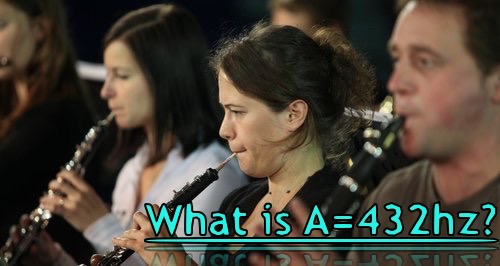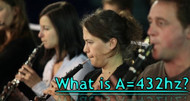What is A=432Hz?
Posted by Jeff Howard on 13th Apr 2023

A=432Hz is a specific tuning standard used in music, where the note A above middle C is tuned to a frequency of 432 Hertz (Hz). This frequency is considered by some to have spiritual and healing properties, and is often associated with a more natural and harmonious sound compared to the commonly used tuning standard of A=440Hz.
Proponents of A=432Hz argue that it is a more natural frequency that is in alignment with the rhythms and vibrations of the universe and the human body. They claim that music tuned to this frequency can have a positive effect on physical and emotional well-being, and can promote feelings of calmness, relaxation, and inner peace.
A=432Hz is often used within the context of the 12-tone equal temperament system, which is the most commonly used tuning system in Western music. The 12-tone equal temperament system divides the octave into 12 equal parts, so each half-step is equal in size. In this system, A4 is typically tuned to 440Hz.
However, A=432Hz can also be used in alternative tuning systems, such as just intonation or Pythagorean tuning, where the intervals between notes are based on whole number ratios or natural harmonics. In these tuning systems, the relationship between A and other notes is based on frequency ratios rather than fixed pitch values.
So while A=432Hz can be used within the 12-tone equal temperament system, it is not limited to this system and can also be used in alternative tuning systems that are based on different principles.
While there is no scientific evidence to support the claims, many musicians and sound therapists continue to use A=432Hz as a tuning standard, and it has gained a following in certain circles.
The mysticism surrounding 432Hz tuning is based on several beliefs and theories, some of which are rooted in ancient cultures and spiritual practices.
One theory is that the number 432 is significant in many ancient cultures and traditions, such as the ancient Indian Vedic tradition, where it is believed to be a sacred number related to the cycles of the sun, moon, and Earth. In other cultures, 432 is also associated with spiritual concepts such as the distance between the Earth and the Sun, the diameter of the Sun, and the precession of the equinoxes.
Another theory is that 432Hz is a more natural frequency that is in tune with the vibration of the universe and the human body. This belief is based on the idea that everything in the universe is vibrating at a specific frequency, and that the human body has a natural resonance with this frequency. According to this theory, music tuned to 432Hz can help to balance and harmonize the body's energy, promoting feelings of calmness, relaxation, and inner peace.
The numerological concepts associated with 432Hz tuning are based on the belief that numbers and their vibrations have a spiritual significance and can influence human consciousness and well being. Some proponents of 432Hz tuning believe that the number 432 has a special spiritual significance and that tuning to this frequency can have a positive effect on the body and mind.
One theory is that the number 432 is connected to the cycles of the universe and the natural world. For example, the diameter of the sun is approximately 864,000 miles (twice 432,000), and the number of seconds in a day is 86,400 (again, twice 43,200). Proponents of 432Hz tuning believe that this suggests a connection between 432 and the natural cycles of the universe.
Another numerological idea is that the number 432 is connected to the human body and its energy systems. Some proponents believe that the number 432 represents the frequency of the base chakra, which is associated with grounding, stability, and the physical body. According to this theory, tuning music to 432Hz can help to balance and harmonize the body's energy, promoting feelings of calmness, relaxation, and inner peace.
The modern-day popularity of 432Hz tuning can be attributed to a few key factors.
One of the earliest proponents of 432Hz tuning in the modern era was the French musician and musicologist Joseph Sauveur, who in the early 18th century proposed a tuning system based on the natural harmonics of sound, with A set to 432Hz. However, this system did not gain widespread acceptance at the time.
More recently, the popularity of 432Hz tuning has been fueled by the rise of the New Age movement in the 20th century, which emphasized the spiritual and mystical properties of sound and music. Many musicians and sound healers within the New Age community began using 432Hz tuning as a way to promote relaxation, meditation, and healing.
The internet and social media have also played a role in the popularization of 432Hz tuning, with many online communities and resources dedicated to promoting its use in music. Today, while 432Hz tuning is still not widely accepted as a standard in mainstream music, it has a dedicated following and continues to be used by musicians and sound healers around the world.
The internet has played a significant role in the popularization of A=432Hz tuning. Prior to the widespread use of the internet, information about alternative tuning systems was primarily spread through word of mouth, print publications, and niche music communities. However, the internet has made it much easier for people to access information about different tuning systems, share their own experiences, and connect with like-minded individuals from around the world.
One way the internet has facilitated the popularity of A=432Hz tuning is through online music communities and forums. Many musicians and sound therapists who use alternative tunings, including A=432Hz, have created online communities where they can share their music, techniques, and experiences with others. These communities have helped to create a sense of community and belonging among those who are interested in alternative tuning systems, and have helped to spread awareness and understanding of these systems.
Social media has also played a role in the popularization of A=432Hz tuning. Platforms like YouTube and Instagram have made it easier for musicians and sound therapists to share their work and reach a wider audience. Many musicians and sound therapists who use A=432Hz tuning have created social media accounts to share their music and educate others about the benefits of alternative tuning systems.
Finally, the internet has also made it easier for people to access resources and information about A=432Hz tuning. There are many websites, blogs, and online courses dedicated to teaching people about alternative tuning systems, and the internet has made it possible for people to access this information from anywhere in the world. This has helped to demystify alternative tuning systems and make them more accessible to people who might not have had access to this information otherwise.
There are several alternative tuning systems that exist apart from the standard Western tuning system, which is based on the 12-tone equal temperament system. Here are a few examples:
Pythagorean tuning: This tuning system is based on the natural harmonic series and is named after the ancient Greek philosopher Pythagoras, who discovered the mathematical relationships between musical intervals. In this tuning system, the frequency ratios of the intervals between notes are based on whole number ratios.
Just intonation: This tuning system is similar to Pythagorean tuning in that it is based on the natural harmonic series, but it uses more complex ratios that are closer to the ideal harmonic ratios. Just intonation allows for more pure-sounding intervals and can be used to create more complex harmonies.
Meantone temperament: This is a historical tuning system that was commonly used in the Baroque era. In this system, the intervals between notes are adjusted so that certain keys sound more in tune than others. Meantone temperament can be used to create more expressive and colorful harmonies, but it can also limit the range of available keys.
Quarter-tone tuning: This tuning system divides the octave into 24 equal parts, rather than the standard 12 parts. This allows for the use of microtones, which are notes that fall between the standard notes of the Western system. Quarter-tone tuning is commonly used in Middle Eastern music and can be used to create more complex and intricate melodic lines.
Just-intoned 432Hz: This is a variation of the just intonation system that uses the frequency of A=432Hz as a reference point. In this system, the frequencies of other notes are adjusted based on their relationship to A=432Hz, creating a harmonious and natural-sounding tuning system.
Microtonal tuning systems in which the octave can be split into many more parts, offering whole worlds of expression through tonal coloration.




